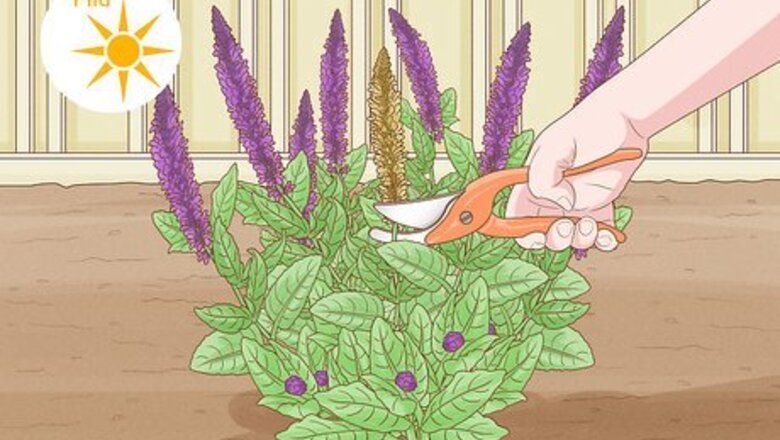
views
Maintaining Rosette Salvia
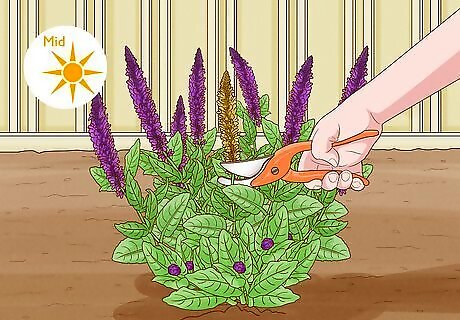
Deadhead the flowers when they fade in summer. Deadheading means trimming off blooms when they first begin to fade. For rosette salvia, the flowers will usually fade towards the middle of the summer and begin dropping seeds. Plan on removing any flowers as soon as they begin turning to a dull green or brown color. Trimming the flowers causes the salvia to bloom a second time. Normal salvia blooms are colorful, so you can easily see when bright blue or violet flowers begin fading.
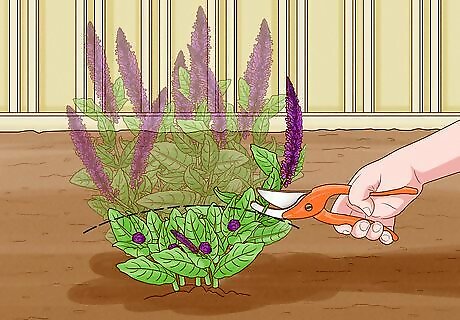
Cut the stems down to the new buds. Examine the highest pair of leaves on the salvia stems. You should see 2 small buds emerging for the leaves. Using a sharp pair of shears, trim the stem right above the leaves and buds. These buds branch off into secondary flower spikes. Rosette-type salvia plants grow stems out of a circle of leaves close to the ground. Tall flower spikes form on these stems. Rosette salvia plants include Woodland Sage, Caradonna, and May Night Sage.
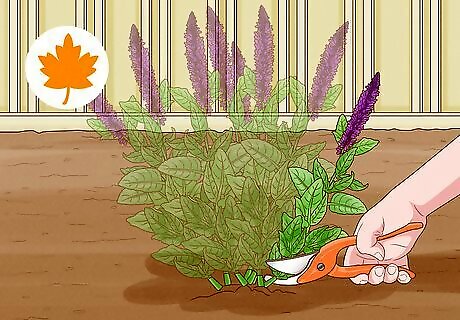
Cut the stems to the ground in fall. The second round of buds will fade by the end of fall. Prepare the salvia for winter by locating the basal foliage, which is the circular cluster of leaves on the ground. The salvia’s flower stalks grow out of it. Snip all of the remaining stems right above these leaves. After trimming the stalks, only the leaves and possibly a small amount of stalk should remain. Be sure to take out any dead plant material you notice, since it can prevent light from reaching the bottom of the plant.
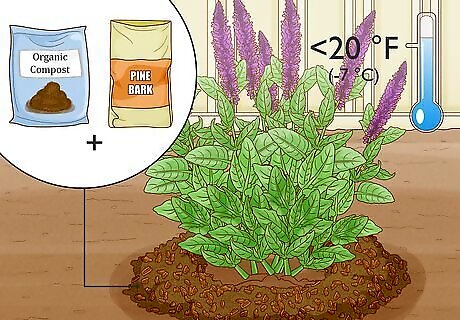
Insulate the plant if winter temperatures drop below 20 °F (−7 °C). Rosette salvia plants are hardy, but pruning can leave them exposed to cold temperatures. You can protect them by spreading an organic compost, followed by an organic mulch like pine bark. Spread these products as far as the pruned salvia reaches, but avoid letting it touch the plant’s stem. You can also cover the plant with fleece or leaf-filled garbage bags and a tarp. Weigh these items down to keep them in place. The first frost happens around fall when the temperatures drop below 32 °F (0 °C).
Pruning Deciduous Herbaceous Salvia
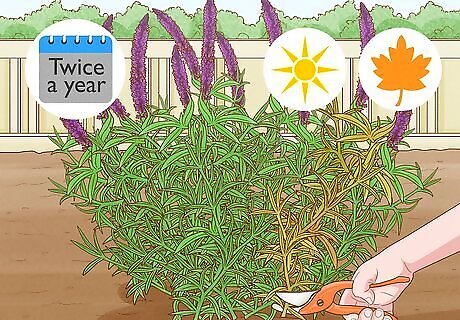
Prune off dead stems and leaves at least twice a year. Aim on tending to the salvia at least in summer and fall. This type of salvia can spread rapidly, turning into a knotted mess. To make pruning easier, you can cut off any dark or ragged portions as you notice them throughout the growing season. Deciduous herbaceous salvia are shrub-like plants with soft stems, so they can rot and decay if you aren't careful. This type of salvia is typically a perennial that fades in winter, so pay extra attention to the plant during the fall. Some examples of this type of salvia are Mexican Bush Sage, Nekan, and Pineapple Sage.
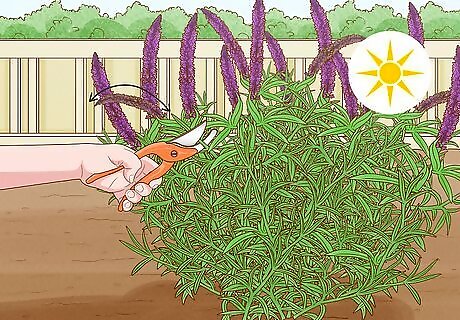
Deadhead flowers after they begin wilting in summer. You may begin seeing colorful blooms on the salvia near the beginning of summer. When they begin fading and wilting, use a sharp pair of shears to trim the blooms. Make your cuts below any wilted segments on the stems. Since this type of salvia grows quickly, it may produce a second round of blooms before winter.
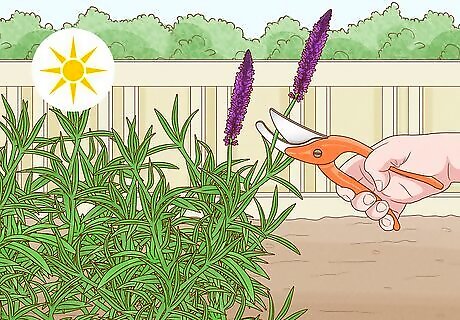
Trim branches and stems down to the leaves in summer. As you remove the old flowers, cut the plant's stems to size as well. Locate the highest leaves on each stem, then cut the stem tips down to them. Try to keep all sides of the salvia plant an even length, removing branches as needed to thin the bush. Cut the plant at this time so it looks pleasant and stays within its growing area. Taking out old growth in the middle of the shrub provides room for new shoots and flowers.
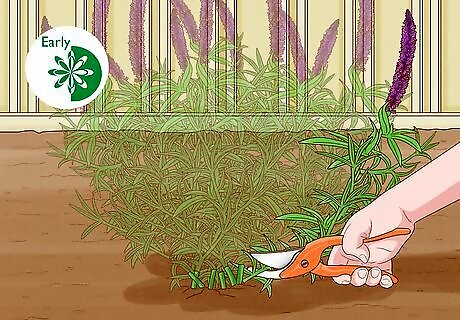
Cut the salvia to the ground in early spring. Work on the salvia right after the final frost in your area to prepare the plant for the growing season. You can cut the plant low, leaving the stems barely sticking out of the soil. The last frost varies depending on where you live. It happens at the end of winter, when the temperature goes below 32 °F (0 °C) for the last time.
Maintaining Herbaceous Woody Saliva
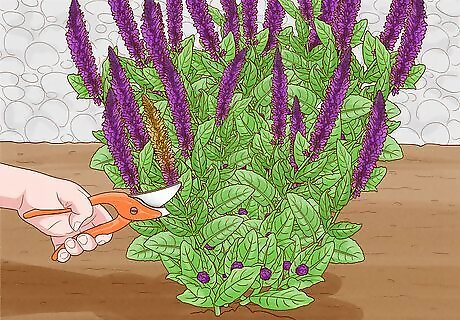
Deadhead flowers all year as they fade. This variety of salvia plant blooms most often in spring and fall, although you may notice flowers in other seasons as well. Wait for the bright, colorful flowers to begin dulling, turning green or brown. Then, use shears to cut underneath the bud or pinch the flower off by hand. Throw the flower away so it doesn’t rot in nearby soil.
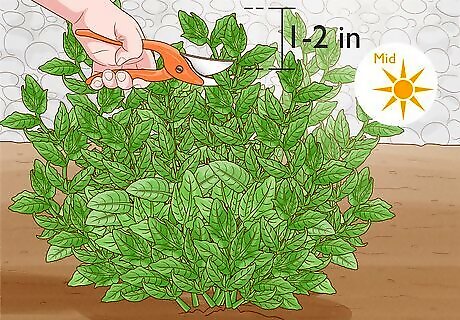
Prune stems down to the leaf clusters in the middle of summer. Look for the highest leaf cluster on each stem. Avoid cutting below this point. Reduce each stem by 1 to 2 in (2.5 to 5.1 cm) to prevent the salvia from overgrowing during the warmer months. Work from side to side to ensure you get each stem. This type of salvia is a shrub which can grow hard stems. Trimming the stems helps prevent woody growth. Autumn Sage is a very common woody sage. A few others are Hot Lips Sage and Orange Mountain Sage.
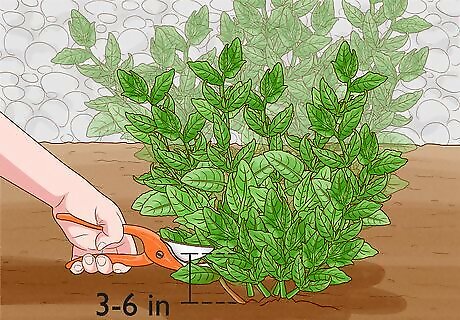
Thin out the plant by removing old branches in summer. Work slowly, taking out an equal amount of branches from the sides and middle of the salvia. Using pruning shears, make your cuts where the branches divert from nearby branches. Leave the remaining stems about 3 to 6 in (7.6 to 15.2 cm) long. You can do this to sculpt the salvia as well as let light into its center.
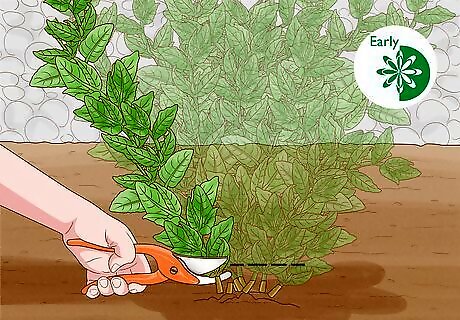
Cut the remaining stems to the ground in early spring. Finish pruning the salvia around the time of the final frost. Use your shears to cut all of the stems close to the soil. Your salvia bush should then have plenty of space to grow back again. If you don’t cut the stems during this time, they will harden and appear ragged. Cut the bush even if it is still green.
Pruning Evergreen Salvia
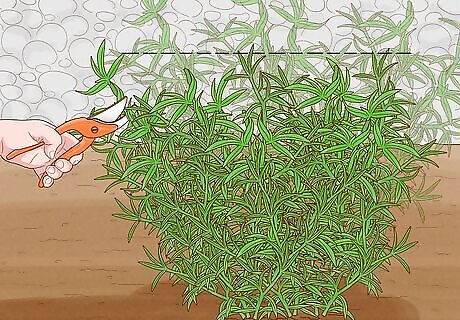
Trim the salvia branches throughout the year to control growth and shape. Evergreen salvia grows from spring to fall. Like with most hedges, routine trimming helps keep the plant from overgrowing. Using shears, trim all of the branches down to the size you want the plant to be. Cut the plant evenly on all sides. You should trim the plant at least once in fall, but consider doing it whenever you notice the bush becoming overgrown. Evergreen salvia plants are often used as sculpted hedges because they have hard stems and stay green all year.
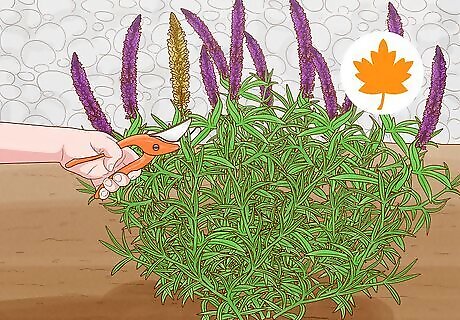
Trim off damaged flowers and branches in fall. The plant’s flower blooms will begin fading around the beginning of fall. Trim off all of the flowers, then check for broken, rotting, or overgrown branches. Prune the branches sparingly, removing the damage. Avoid pruning the branches far back during the fall, since it can spur new growth that won’t survive the winter.
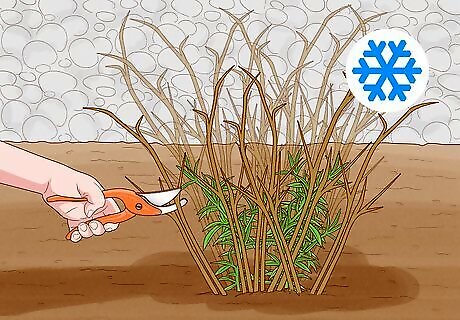
Reduce the branches with a more thorough pruning in winter. Evergreen salvia bushes are generally dormant in winter. During this time, you can safely reduce them to a size that fits your yard space. Reduce the remaining branches to the length you desire, trimming the salvia evenly on all sides. Cut off any branches that are tangled or too close together. Continue looking for and trimming away any signs of damage.
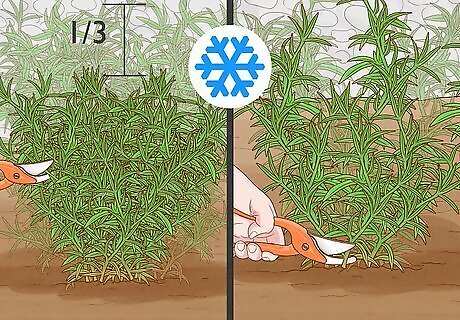
Cut overgrown salvia to ⅓ of its original size in the winter. Neglected or overgrown evergreens benefit from a more severe pruning session. First, cut the entire plant down, keeping all sides even. Then, look for any spots that look thick with branches. You can remove some of the branches to let in air and sunlight. Although winter is the ideal time for this sort of pruning, if the salvia bush is in bad condition, you may need to take care of it right away. You can remove up to ⅓ of the branches. Thinning out the middle of the bush is important, but avoid removing too many branches. If the salvia is heavily damaged, you may need to cut it down further until it is 12 to 18 in (30 to 46 cm) in size.


















Comments
0 comment